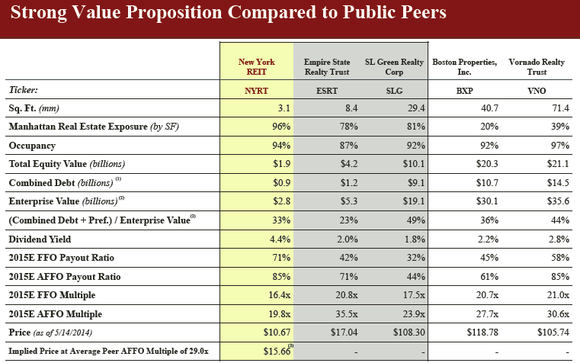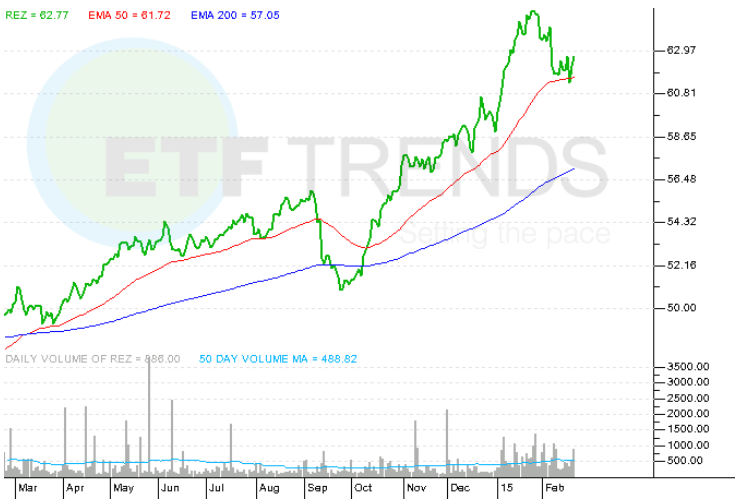Residential REITs With Highest New York City Exposure
Post on: 19 Июнь, 2015 No Comment

Many have pointed to the increased strength of the residential apartment sector. The main source of their optimism stems from the continued economic uncertainty and lack of credit, which prevents people from purchasing their own homes both because of internal and external factors. New York City, because of various economic factors, mostly relating to supply (apartment units) and demand (population) remains the strongest performer in the residential real estate market. Consider the following table based on information from Rentbit.com
$1,589
Besides for San Francisco — whose meteoric rise in rents is a recent phenomenon — Boston remains the closest competitor to New York City in rental rates, but trails by nearly 40%! Therefore, if we want to see which Residential REIT’s have the strongest future prospects, we must examine their exposure to the New York City rental market — by far the strongest in the country.
Publicly traded residential REITs currently number 14, of those 14 only five have any presence in NYC, and of those five, only three have a significant presence — Equity Residential (NYSE:EQR ), AvalonBay (NYSE:AVB ), and UDR (NYSE:UDR ), the other two, AIMCO (NYSE:AIV ), and Post Properties (NYSE:PPS ) have under 1.5% of their portfolio in the NYC market.
In this article I will examine, which of the above three — EQR, AVB, and UDR — give investors the best exposure to the NYC market, and try to draw some general conclusions as to their relative attractiveness as investments in general.
EQR
EQR has by far the largest portfolio — just over 120,000 units — out of the three REITs under discussion. Its portfolio currently spans the entire USA, operating in 16 different markets, but despite this range New York City has the most share of the revenue in EQR’s portfolio, with just over $142mm (13.3%) of stabilized NOI (Income generated from properties less expenses). This high level of concentration in the NYC market shows that EQR’s management deeply understands the importance of having a major presence in this market. However, when analyzing the portfolio we also must look at EQR’s development pipeline to get a sense of the future possibilities EQR has in NYC.
EQR currently has three developments underway in NYC.
- 500 West 23rd Street — 111 units
- 400 Park Avenue South, joint venture with Toll Brothers (NYSE:TOL ) — TOL will sell their units as condos, and EQR will rent out their 265 units in the building.
- 170 Amsterdam Avenue (ground lease) — 230 Units.
In total, these 606 new units will add about 1 cent in EPS to EQR, not material to EQR considering they earned $2.95 per share last year.
In addition to the above, rumors have spread that EQR will buy The Beatrice to add 302 units to their portfolio. I don’t know the status of these rumors but EQR has already taken over leasing responsibilities on their website (though could have been part of a previous management agreement).
Obviously, EQR has many more ways to dramatically expand their NYC portfolio through further acquisitions beyond the developments listed above, but in terms of certainty, we can only have confidence in the above mentioned developments. Additionally, we should note that EQR made an aggressive push to acquire Archstone, which has a large NYC presence, earlier this year, but ultimately did not succeed in acquiring the property (though they did make money from the break-up fee). We see from this, EQR’s desire to acquire multi-family properties, and specifically ones in NYC, a trend that could continue into the future.
AVB
AVB has a portfolio of 53,000 apartments around the USA, with just under $118mm or 13% of gross rent generated from NYC. Turning our attention to AVB’s development pipeline we see a robust future:

- West Chelsea — 715 units
- Avalon Willougby Square — 861 units.
- Avalon Garden City — 204 units.
In addition to these 1,680 units under development, AVB has developments in areas located a short distance from NYC both on the most eastern parts of New Jersey, and further out in the boroughs. These two developments should add 43 cents of EPS to AVB’s bottom line, or an 8% increase over last year’s EPS.
AVB hasn’t rattled its saber as much as EQR, but I don’t think we should take that as a sign of a lack of enthusiasm for the NYC market. AVB has a much stronger development pipeline than EQR, and as such does not need to constantly scour the city for new sites. The fact that AVB has more control over its own destiny in NYC should give investors calm when deciding where they want to invest their money.
UDR
UDR has a portfolio of 47,000 units located across the country with only a small and relatively new portion of their portfolio located in NYC. Since they acquired their NYC portfolio relatively recently, they did not yet have full year earnings to report from these properties, but taken as a percentage of their total units. the NYC portfolio makes up 4% of their portfolio.
Despite the fact that UDR does not have any developments planned for NYC, they have expanded aggressively and quickly in NYC. Since first entering the NYC market in March 2011 — UDR has acquired 5 multi-family properties, for a total of 2,626 units. Their rise has been intense, and in the words of their CFO the company has, been, walking up and down the streets one asset will not be enough We can safely assume that UDR will continue to build their NYC portfolio, which will continue to add to their bottom line going forward.
Conclusions
Obviously when evaluating these REITs, we need to consider other elements of the company, most importantly areas the companies operate in, their internal operating efficiency, debt and equity positions, to name a few. However, when considered through this narrow lens I think we can draw the following conclusions:
1. EQR, because of its huge size, will have to work very hard to move the needle on their EPS going forward, both in terms of their NYC strategy, and their national strategy. Their size does allow them to weather more storms, and provides for a greater amount of stability, but their lack of potential upside in stock appreciation should worry investors. In fact, I would argue, that their size, while double that of AVB or UDR, does not provide them with that much more stability than their competitors, and precludes from making changes that will affect EPS going forward.
2. AVB has demonstrated a strong commitment to NYC both with their current portfolio, and their development pipeline. Their ability to develop properties has allowed them to move forward with a greater degree of certainty than their competitors, and will allow investors to see more certain returns going forward.
3. UDR, while they have made a very strong and aggressive push in the NYC market, they have not proven themselves as long time operators in NYC. Their stated optimism on NYC should comfort investors, but their lack of a track record still places them as a wild card.
All of these companies have stated both orally, and in their 10-K’s that they want to dispose of their assets in non-core markets, and focus on the coastal gateway cities, for future development. These REITs, as opposed to others that traffic almost exclusively in second tier markets, will give investors greater long term value going forward. I personally like AVB for the reasons mentioned above, but I think depending on the results of a fuller analysis that takes into account some of the variables mentioned above, I could come to a different conclusion.
Disclosure: I have no positions in any stocks mentioned, and no plans to initiate any positions within the next 72 hours.














